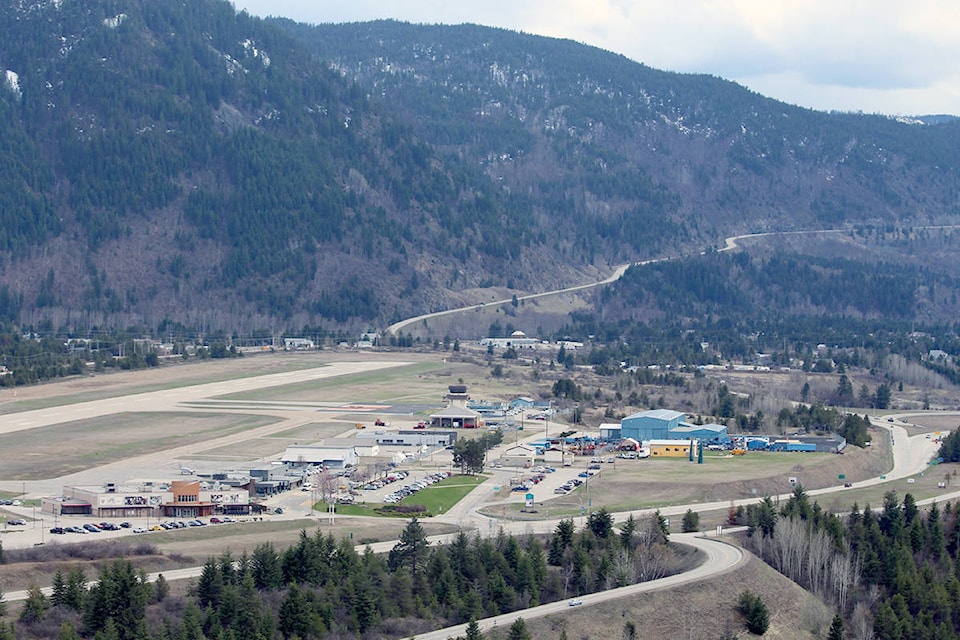The City of Castlegar has released a summary of its new airport master plan — a document that will guide future development of the West Kootenay Regional Airport for the next 25 years.
The plan is all-encompassing and looks at everything from ground access and runways to terminal and service buildings. It also analyzes air navigation infrastructure, utilities, emergency response services, noise management, environmental planning, security and land use.
The plan projects that the airport will be Required Navigation Performance (RNP) capable by 2024. RNP is an instrument-based landing procedure that the city hopes will solve the airport’s cancellation woes.
RELATED: Castlegar CAO predicts airport navigation breakthrough
Once RNP is approved, the projection for passenger load, which historically has been about 50 per cent, jumps to 62 per cent due to improved reliability.
It is also projected that passenger demand will grow by 25 per cent by the end of 2024, reaching 95,000 passengers.
Terminal building
The plan sets out some areas of the terminal building that need improvement including the pre-board screening area and hold room, the air-side arrival and departure doors, Canadian Air Transport Security Authority facilities, the boardroom, cafe, display screens and signage.
It includes a modest expansion of the pre-board screening area, adding a line to allow passengers to drop their checked luggage for screening, but then return to the amenities of the concourse until their flight is called. It also includes expansion of the hold room to 93 seats and standing room for 24, with the addition of a washroom and vending.
An expanded arrivals area would feature 16 metres of baggage belt frontage and an oversize baggage chute.
Other suggested improvements include a new administration suite, new check-in counters, airline offices, refurbished washrooms, upgraded cafe kitchen and retail concession.
Ground-side access
The land-side access improvements in the plan primarily focus on improving traffic flow at the main terminal entrance from the highway and adding a second access at the south end of the airport lands.
At the main entrance, a new traffic circle would allow traffic headed to the neighbouring casino to go straight there instead of circling through the airport parking area and drop-off zone like it does now.
Revenue plan
Several opportunities for increasing revenue at the airport are included in the plan.
A key element would be increasing passenger departure fees, which are currently set at $7. The plan suggests raising the fees to a minimum of $12.50. This could generate up to $600,000, which would then be earmarked to pay for projects such as the terminal expansion.
Raising parking fees is another opportunity to increase revenue.
At the time the report was written, parking fees had remained the same since 2002. Castlegar council has however made a move towards increasing the fees since then with half-hour fees increasing from 50 cents to $1, and daily parking fees from $5 to $8. Longer-term rates are $50 per week, $195 per month and $800 per year.
The increases fall in line with the plan’s suggestions.
Other revenue opportunities include revised aeronautical fees, land leases, fuel sales and commercial and light industrial developments.
Plan implementation
The master plan states that “the capacity development and associated infrastructure for the continued growth and development of the West Kootenay Regional Airport will require strategic, well managed and phased investments triggered by actual demand.”
The report lays out three phases for capital improvements with specific development triggers. Even though the phases are connected to targeted years, meeting the development triggers is what would kick off the next stage of development.
The first phase looks at the next five years with the development triggers being improved approach/departure through approval of RNP procedures and airline participation. Other triggers include service by Q400 or DH-8-300 aircraft, additional scheduled flights during peak hours, growing demand for general aviation hangar space and demand for development lands.
The first infrastructure to be improved would be an apron expansion, new approach lighting, terminal building expansion, taxiway expansion, entrance road and roundabout and services to commercial lots.
Phase two is targeted for 2025 to 2029.
Triggers include additional frequency of flights, growth in passenger traffic and new air services.
Infrastructure requirements would be an apron expansion, general aviation lots and hangars, runway extension, taxiway work and additional airport access for commercial areas.
Phase three is targeted for 2030 to 2034.
Development triggers are additional air carrier frequency, new cargo or logistics operations and growth in general aviation activity.
Infrastructure requirements for phase three include a full parallel taxiway, additional general aviation lot development, terminal building expansion, improved passenger facilitation process and expanding lease lots.
Continual improvement of the West Kootenay Regional Airport has been a strategic priority of Castlegar city council for years, recognizing that it has the potential to be a major economic driver for the entire region.
betsy.kline@castlegarnews.com
Like us on Facebook and follow us on Twitter
